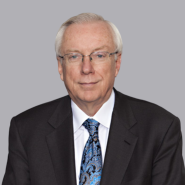PTAB ADOPTS IDENDEX IN FINDING MARKUSH GROUP NOT ENABLED
- September 7, 2021
- Article
Associated People
Associated Practices
Associated Technologies
In Post Grant Reviews (PGR) the Patent Trial and Appeal Board (PTAB) may consider all statutory challenges to patent claims including those under 35 U.S.C. § 112. One such challenge was brought in Syngenta Crop Protection v. FMC Corp in PGR2020-00028 (Syngenta), decided August 31, 2021, against U.S.P. 10,294,202 (‘202 patent). The PTAB found all challenged claims, 1-3, 9-13, and 21-30, unpatentable as lacking an enabling disclosure commensurate in scope with the claims and a subset, claims 9 – 13, as lacking written description, 35 U.S.C. § 112(a).
The ‘202 patent is directed to pyrrolidinone herbicides:
1. A compound selected from Formula I, N-oxides and salts thereof :
Followed by Markush definitions of each variable covering almost 4 pages of the opinion. The Petitioner asserted, the PTAB agreed, and patentee did not deny that the claims cover over a billion compounds. The PTAB found on a largely undisputed record that the level of skill in the art was relatively high but the art unpredictable. The PTAB also found that Q1, Q2, R1, and R6 groups alone each recite well over a thousand possible independent options. The issue was then the degree of guidance provided in the specification for practicing the full scope of the claims.
The PTAB noted that the specification provides no disclosure of the compounds’ mode of action. The PTAB acknowledged that the patentee need disclose an invention’s mode of action citing Alcon Research Ltd. v. Barr Labs., Inc., 745 F.3d 1180, 1190 (Fed. Cir. 2014). The Patent Owner admitted that without this information to practice the full scope of the claims, ordinarily skilled artisans must engage in iterative QSAR modeling to develop a structure-activity relationship themselves. The evidence was that knowledge of the mode of action would have assisted in the QSAR modeling process. The Patent Owner’s expert testimony to the contrary was rejected on this point because almost half of its expert’s 150-plus publications provided a mode of action and only a few provided QSARs for herbicides.
The ‘202 patent specification had over 350 examples of synthesizing compounds and herbicidal activity for 335 of the compounds. The PTAB noted that the Patent Owner correctly argued there was no requirement either (1) the Specification to disclose testing of “each” claimed compound and modifying of “each” claimed variable, or (2) that an ordinarily skilled artisan know in advance precisely all the compounds that will show herbicidal activity. But that the law required that that “the specification must contain sufficient disclosure to enable an ordinarily skilled artisan to make and use the entire scope of the claimed invention at the time of filing,” citing MagSil Corp. v. Hitachi Global Storage Techs., Inc., 687 F.3d 1377, 1382 (Fed. Cir. 2012) (emphasis added). The PTAB then framed the question as be whether the ‘202 patent examples demonstrated variation sufficient to guide the selection and use of non-exemplified compounds within the scope of the claims.
The examples were not the Patent Owner’s friend. The examples demonstrated that some of compounds with a pyrazole group, a member of the Markush group, at Q1 had little or no utility as herbicides. Only the compounds with Phenyl or substituted phenyl at these positions demonstrated herbicidal activity. PTAB noted that thousands of heterocyclic groups were possible at R1 none of which were exemplified other than the pyrazoles some of which were inactive. One-third of the compounds where Q2 was not a phenyl group showed no activity. Similar issues existed for other variables on the claimed herbicides.
The Patent Owner sought to justify the limited scope of the examples by arguing that early filing of an application with a disclosure of novel compounds is to be encouraged. The PTAB rejected the argument based on In re Surrey, 370 F.2d 349, 355 (CCPA 1966) that one is “not entitled to a claim for a large group of compounds merely on the basis of showing that a selected few are useful and a general suggestion of a similar utility in the others.” The PTAB also relied on MagSil, 687 F.3d at 1381 for the proposition that enablement prevents “overbroad claiming that might otherwise attempt to cover more than was actually invented.”
The takeaway is that one needs to reasonably assure that all members of Markush group have the recited utility whether claimed or not in the unpredictable arts. While actual experiments are not mandatory some method must be employed. Complicating the Patent Owner’s challenge was that the patent claims asserted that the claimed compounds were herbicides. Based on the PTAB’s reasoning, even had the claims been silent as to utility, the enablement requirement would still have been issue since the 35 U.S.C. §112(a) requires “. . . and of the manner making and using it, in such full, clear, concise, and exact terms as to enable any person skilled in the art to which it pertains, or with which it is most nearly connected, to make and use the same, . . ..” When presenting Markush claims one should present claims of varying scope with at least some derived from compounds demonstrated to have the use recited. That is, the inventors can explain why the members of the reduced group would function similarly to the exemplified ones.
Recent Publications
Federal Circuit Holds Prosecution History Disclaimer Applicable to Design Patents
by Sana Tahir, Law Clerk and Andrew Ollis, Partner










 Counseling & Strategic Advice
Counseling & Strategic Advice IP Transactions
IP Transactions Litigation
Litigation PTAB Proceedings
PTAB Proceedings Technology Transfer
Technology Transfer Trademark & Designs
Trademark & Designs U.S. Patent Procurement (Application Drafting & Prosecution)
U.S. Patent Procurement (Application Drafting & Prosecution)








